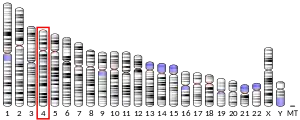Latrophilin 3
Latrophilin 3 is a protein that in humans is encoded by the ADGRL3 gene.[5][6]
Function
This gene encodes a member of the latrophilin subfamily of G protein-coupled receptors (GPCR). Latrophilins may function in both cell adhesion and signal transduction. In experiments with non-human species, endogenous proteolytic cleavage within a cysteine-rich GPS (G-protein-coupled-receptor proteolysis site) domain resulted in two subunits (a large extracellular N-terminal cell adhesion subunit and a subunit with substantial similarity to the secretin/calcitonin family of GPCRs) being non-covalently bound at the cell membrane.[6]
Clinical significance
A version of this gene has been linked to attention deficit hyperactivity disorder (ADHD).[7]
See also
References
- GRCh38: Ensembl release 89: ENSG00000150471 - Ensembl, May 2017
- GRCm38: Ensembl release 89: ENSMUSG00000037605 - Ensembl, May 2017
- "Human PubMed Reference:". National Center for Biotechnology Information, U.S. National Library of Medicine.
- "Mouse PubMed Reference:". National Center for Biotechnology Information, U.S. National Library of Medicine.
- Hayflick JS (Jan 2001). "A family of heptahelical receptors with adhesion-like domains: a marriage between two super families". Journal of Receptor and Signal Transduction Research. 20 (2–3): 119–31. doi:10.3109/10799890009150640. PMID 10994649. S2CID 19919738.
- "Entrez Gene: LPHN3 latrophilin 3".
- Arcos-Burgos M, Jain M, Acosta MT, Shively S, Stanescu H, Wallis D, et al. (Nov 2010). "A common variant of the latrophilin 3 gene, LPHN3, confers susceptibility to ADHD and predicts the effectiveness of stimulant medication" (PDF). Molecular Psychiatry. 15 (11): 1053–66. doi:10.1038/mp.2010.6. PMID 20157310.
Further reading
- Südhof TC (2001). "alpha-Latrotoxin and its receptors: neurexins and CIRL/latrophilins". Annual Review of Neuroscience. 24: 933–62. doi:10.1146/annurev.neuro.24.1.933. PMID 11520923.
- Ushkaryov YA, Volynski KE, Ashton AC (Apr 2004). "The multiple actions of black widow spider toxins and their selective use in neurosecretion studies". Toxicon. 43 (5): 527–42. doi:10.1016/j.toxicon.2004.02.008. PMID 15066411.
- Soares MB, Bonaldo MF, Jelene P, Su L, Lawton L, Efstratiadis A (Sep 1994). "Construction and characterization of a normalized cDNA library". Proceedings of the National Academy of Sciences of the United States of America. 91 (20): 9228–32. doi:10.1073/pnas.91.20.9228. PMC 44785. PMID 7937745.
- Sanger Centre, The; Washington University Genome Sequencing Cente, The (Nov 1998). "Toward a complete human genome sequence". Genome Research. 8 (11): 1097–108. doi:10.1101/gr.8.11.1097. PMID 9847074.
- Nagase T, Ishikawa K, Suyama M, Kikuno R, Miyajima N, Tanaka A, Kotani H, Nomura N, Ohara O (Oct 1998). "Prediction of the coding sequences of unidentified human genes. XI. The complete sequences of 100 new cDNA clones from brain which code for large proteins in vitro". DNA Research. 5 (5): 277–86. doi:10.1093/dnares/5.5.277. PMID 9872452.
- Kreienkamp HJ, Zitzer H, Gundelfinger ED, Richter D, Bockers TM (Oct 2000). "The calcium-independent receptor for alpha-latrotoxin from human and rodent brains interacts with members of the ProSAP/SSTRIP/Shank family of multidomain proteins". The Journal of Biological Chemistry. 275 (42): 32387–90. doi:10.1074/jbc.C000490200. PMID 10964907.
- Bjarnadóttir TK, Fredriksson R, Höglund PJ, Gloriam DE, Lagerström MC, Schiöth HB (Jul 2004). "The human and mouse repertoire of the adhesion family of G-protein-coupled receptors". Genomics. 84 (1): 23–33. doi:10.1016/j.ygeno.2003.12.004. PMID 15203201.
External links
- PDBe-KB provides an overview of all the structure information available in the PDB for Human Adhesion G protein-coupled receptor L3
- PDBe-KB provides an overview of all the structure information available in the PDB for Mouse Adhesion G protein-coupled receptor L3
This article incorporates text from the United States National Library of Medicine, which is in the public domain.



